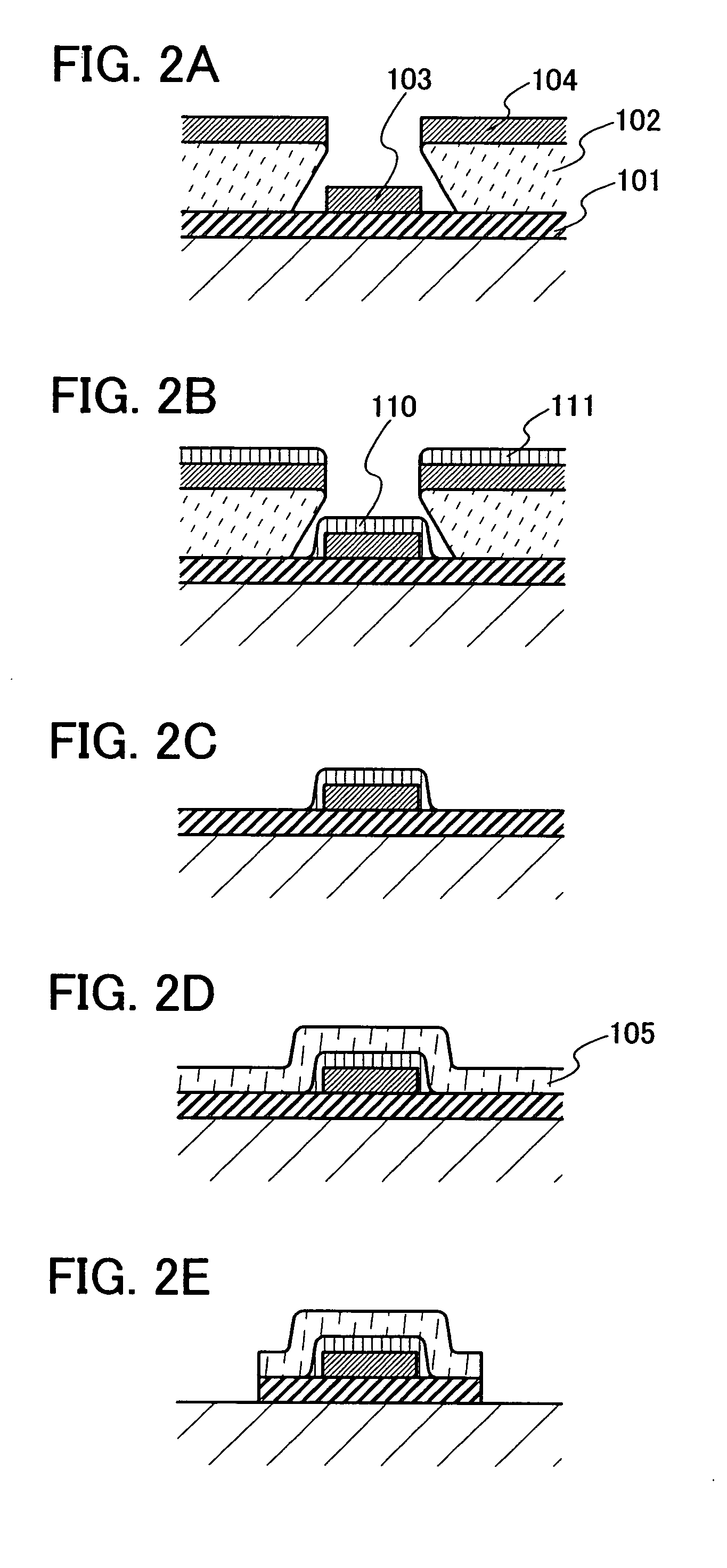Display device and manufacturing method of the same
- Summary
- Abstract
- Description
- Claims
- Application Information
AI Technical Summary
Benefits of technology
Problems solved by technology
Method used
Image
Examples
embodiment mode 1
[0053] Embodiment Mode 1 will describe a manufacturing method of a wire using a low resistance material, with reference to FIGS. 1A to 1F.
[0054] First, a first conductive film 101 serving as a barrier layer is formed over a surface 100 (hereinafter, also referred to as a formation surface) to be provided with a wire (FIG. 1A). As a material of the first conductive film 101, any of tungsten (W), molybdenum (Mo), chromium (Cr), titanium (Ti) and tantalum (Ta), which are high melting point materials, or an alloy thereof (e.g., W—Mo, Mo—Cr, or Ta—Mo), or a nitride thereof (e.g., tungsten nitride (WNx), titanium nitride (TiNx), tantalum nitride (TaNx), or TiSiNx), or the like can be used. A sputtering method, a CVD method or the like can be adopted as the formation method.
[0055] Then, a resist mask 102 is selectively formed over the first conductive film 101 (FIG. 1B). At this time, the resist mask 102 is selectively formed so as to expose a region in which a second conductive film 103...
embodiment mode 2
[0063] Embodiment Mode 2 will describe another mode of a manufacturing method of a wire using a low resistance material, with reference to FIGS. 2A to 2E.
[0064] As in Embodiment Mode 1, second conductive films 103 and 104 are formed over first conductive film 101 and a resist mask 102 (FIG. 2A). As a material of the first conductive film 101, any of tungsten (W), molybdenum (Mo), chromium (Cr), titanium (Ti), and tantalum (Ta), which are high melting point materials, or an alloy thereof (e.g., W—Mo, Mo—Cr, or Ta—Mo) or a nitride thereof (e.g., tungsten nitride (WNx), titanium nitride (TiNx), tantalum nitride (TaNx), or TiSiNx), or the like can be used. A sputtering method, a CVD method, or the like can be adopted as the formation method.
[0065] As the materials of the second conductive films 103 and 104, copper (Cu) is preferable; however, there is no particular limitation as long as they are low resistance materials. For example, silver (Ag), aluminum (Al), gold (Au), an alloy the...
embodiment mode 3
[0073] Embodiment Mode 3 will describe a manufacturing method of a bottom-gate type thin film transistor (hereinafter referred to as a TFT) using a low resistance material as a wire, with reference to FIGS. 3A to 3F and 4A to 4E.
[0074] A wire 201 serving as a gate electrode is formed over a substrate 200 by the method shown in Embodiment Mode 1 (FIG. 3A). A thickness of the wire 201 is preferably 10 nm to 200 nm. The wire 201 includes a stacked structure of a first conductive film 201a, a second conductive film 201b, and a third conductive film 201c. In this embodiment mode, the second conductive film 201b formed from a low resistance material is not formed in a region which is to become a gate electrode later. In other words, the second conductive film 201b corresponding to the second conductive film 103 shown in FIG. 1F is not shown in FIGS. 3A to 3F and 4A to 4E, which show a cross-section of the thin film transistor. On the other hand, as shown in FIG. 4E, which is a top view, ...
PUM
| Property | Measurement | Unit |
|---|---|---|
| Angle | aaaaa | aaaaa |
| Angle | aaaaa | aaaaa |
| Length | aaaaa | aaaaa |
Abstract
Description
Claims
Application Information
 Login to View More
Login to View More - R&D
- Intellectual Property
- Life Sciences
- Materials
- Tech Scout
- Unparalleled Data Quality
- Higher Quality Content
- 60% Fewer Hallucinations
Browse by: Latest US Patents, China's latest patents, Technical Efficacy Thesaurus, Application Domain, Technology Topic, Popular Technical Reports.
© 2025 PatSnap. All rights reserved.Legal|Privacy policy|Modern Slavery Act Transparency Statement|Sitemap|About US| Contact US: help@patsnap.com



